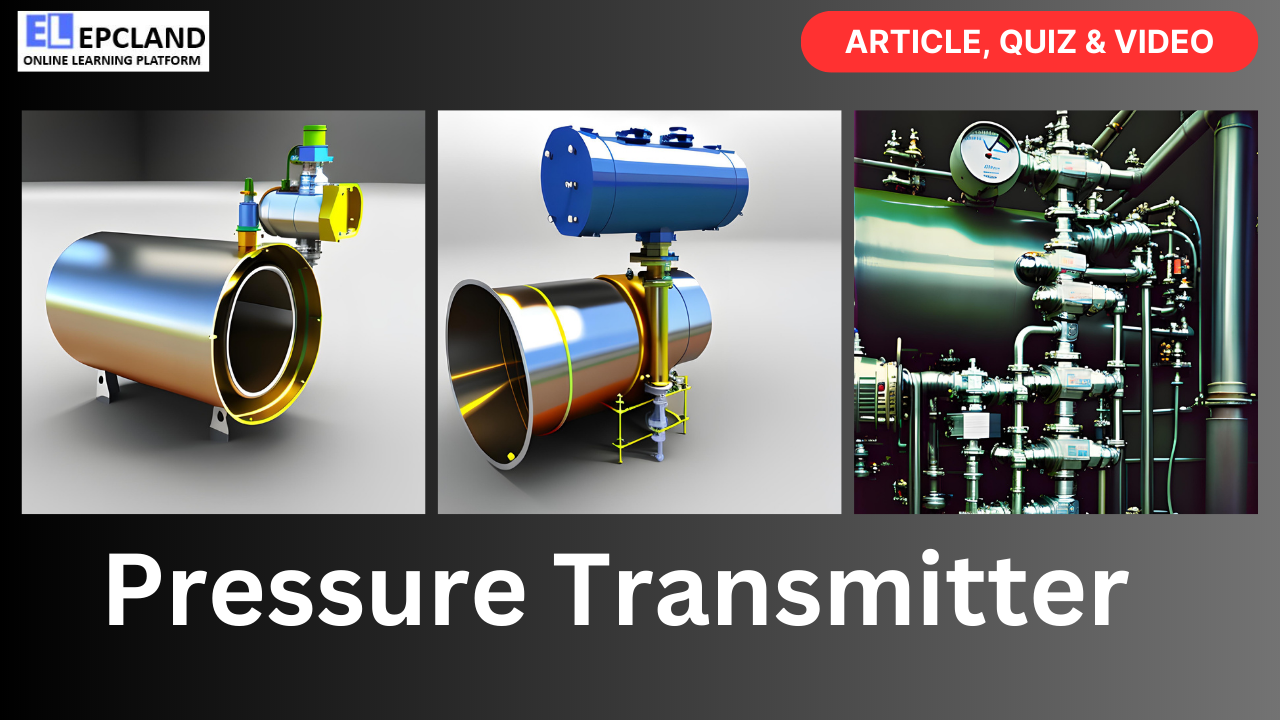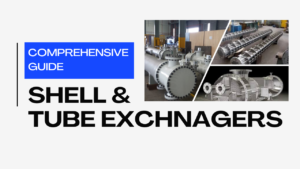Pressure transmitters are vital instruments in the Oil and Gas Industry, playing a pivotal role in ensuring the safe and efficient operation of various processes. These versatile devices are responsible for measuring and transmitting pressure data, a critical parameter in the industry, to control systems. In this article, we will explore the significance of pressure transmitters, their applications, technologies, working principle, and the impact they have on oil and gas projects.
Table of Contents
Do not miss the Complete Course on Piping Engineering
By EPCLand
Introduction to Pressure Transmitters
Pressure transmitters are a subset of instrumentation devices used to measure and convert pressure into an electrical signal. In the Oil and Gas Industry, pressure is a fundamental parameter that must be accurately monitored and controlled for safety, quality, and process optimization. Pressure transmitters are essential tools for achieving these objectives.
The Importance of Pressure Measurement
Pressure is a key variable in numerous oil and gas applications, including:
- Well Monitoring: In drilling and production, pressure data is crucial for assessing reservoir conditions and well integrity.
- Pipeline Operations: Maintaining the right pressure within pipelines ensures the efficient transport of hydrocarbons from production facilities to refineries.
- Refinery Processes: Pressure is closely monitored during various refinery processes, such as distillation, to control temperature and separation efficiency.
- Safety Systems: Pressure transmitters are integral to safety systems, triggering alarms and emergency shutdowns when pressures exceed safe limits.
- Quality Control: Pressure control is vital for ensuring the quality and consistency of products such as liquefied natural gas (LNG).
Pressure Transmitter Technologies
Pressure transmitters employ different technologies to measure pressure accurately. The choice of technology depends on factors like application, operating conditions, and accuracy requirements. Common pressure transmitter technologies include:
1. Strain Gauge Technology:
Strain gauge pressure transmitters use the deformation of a diaphragm to measure pressure changes. The diaphragm contains strain gauges that change resistance when subjected to pressure. This change is converted into an electrical signal and transmitted to control systems.
2. Capacitance Technology:
Capacitance-based pressure transmitters measure pressure-induced changes in capacitance. When pressure is applied, the distance between two capacitor plates changes, altering capacitance. The transmitter converts this change into a proportional electrical signal.
3. Piezoelectric Technology:
Piezoelectric pressure transmitters use the piezoelectric effect, where certain materials generate an electric charge when subjected to mechanical stress (such as pressure). This charge is proportional to the applied pressure and is measured to determine pressure levels.
4. Resonant Silicon Technology:
Resonant silicon pressure transmitters utilize a silicon diaphragm that vibrates at its natural frequency. The pressure causes a change in the diaphragm’s frequency, which is detected and converted into an electrical signal.
5. Differential Pressure Technology:
Differential pressure transmitters measure the difference in pressure between two points. They are often used to monitor flow rates, level, and filter conditions in oil and gas processes.
6. Digital Pressure Sensors:
Digital pressure sensors incorporate microcontrollers and digital signal processing to provide accurate and stable pressure measurements. They are known for their high precision and compatibility with digital communication protocols.
Do not miss the Complete Course on Piping Engineering
By EPCLand
Working Principle of Pressure Transmitters
The working principle of pressure transmitters is based on the fundamental physical properties of materials and their response to mechanical stress. Here’s a simplified explanation of how they work:
- Strain Gauge Technology: When pressure is applied to the diaphragm of a strain gauge pressure transmitter, it causes the diaphragm to deform slightly. This deformation changes the electrical resistance of the strain gauges bonded to the diaphragm. The change in resistance is proportional to the applied pressure. The transmitter measures this change and converts it into an electrical signal, typically a voltage or current signal, which is then transmitted to the control system.
- Capacitance Technology: Capacitance-based pressure transmitters use the principle that the capacitance (ability to store an electrical charge) of a capacitor changes when the distance between its plates changes. In these transmitters, one plate is fixed, and the other is attached to a flexible diaphragm. When pressure is applied, the diaphragm flexes, altering the distance between the plates and, consequently, the capacitance. This change in capacitance is measured and converted into an electrical signal.
- Piezoelectric Technology: In piezoelectric pressure transmitters, certain materials (like quartz) generate a voltage when subjected to mechanical stress or pressure. When pressure is applied to a piezoelectric crystal, it deforms, producing an electrical charge proportional to the applied pressure. This charge is measured and converted into an electrical signal.
- Resonant Silicon Technology: Resonant silicon pressure transmitters use a silicon diaphragm that vibrates at its natural resonant frequency. When pressure is applied, the diaphragm’s resonance frequency changes. This change is detected, and the transmitter converts it into an electrical signal.
- Differential Pressure Technology: Differential pressure transmitters compare the pressure at two different points (often on either side of a diaphragm or across a flow restriction). The difference in pressure between the two points is measured and converted into an electrical signal.
- Digital Pressure Sensors: Digital pressure sensors use microelectronics and digital signal processing to measure pressure accurately. These sensors typically contain a pressure-sensitive element (like a silicon diaphragm) that changes its electrical properties in response to pressure. The sensor converts these changes into digital signals, allowing for precise pressure measurements.
Advantages and Disadvantages of Pressure Transmitters
Here’s a table summarizing the advantages and disadvantages of pressure transmitters:
| Advantages | Disadvantages |
|---|---|
| Accurate and precise pressure measurement | Initial cost can be relatively high |
| Wide range of pressure measurement | Requires periodic calibration |
| Versatile and suitable for various applications | Susceptible to damage in harsh environments |
| Real-time monitoring capabilities | May require specialized installation |
| Compatibility with digital communication protocols | Limited to specific pressure ranges |
| Enhanced safety through alarms and emergency shutdowns | Limited compatibility with certain process fluids |
Applications of Pressure Transmitters in the Oil and Gas Industry
Pressure transmitters find wide-ranging applications throughout the oil and gas value chain. Let’s explore some key areas where these instruments are indispensable:
1. Drilling Operations:
In drilling operations, pressure transmitters are used to monitor wellbore pressures. This information helps prevent blowouts, ensures the integrity of the wellbore, and optimizes drilling performance.
2. Production and Reservoir Monitoring:
Pressure transmitters play a crucial role in reservoir management. They provide real-time data on reservoir pressure, enabling engineers to make informed decisions about production rates and reservoir health.
3. Pipeline Management:
Within the extensive network of pipelines used in the oil and gas industry, pressure transmitters are deployed to maintain safe and efficient operations. They monitor pressure levels, detect leaks, and ensure the proper functioning of pumps and compressors.
4. Refinery and Petrochemical Processes:
Pressure transmitters are integral to refining and petrochemical processes. They help control the pressure in distillation columns, reactors, and separation vessels, ensuring product quality and process efficiency.
5. Safety and Emergency Shutdown Systems:
Safety is a top priority in the industry. Pressure transmitters are vital components of safety systems, triggering emergency shutdowns in the event of abnormal pressure conditions to prevent accidents and protect personnel.
6. Liquefied Natural Gas (LNG) Facilities:
In LNG production and storage facilities, pressure transmitters are used to monitor and control the pressure of cryogenic fluids. Maintaining precise pressure is essential for safe and efficient LNG production.
7. Wellhead Control Systems:
Pressure transmitters are employed in wellhead control systems to regulate the flow of fluids from wells. They help maintain optimal wellhead pressure, control valves, and ensure the safety of wellhead equipment.
Features and Considerations
When selecting pressure transmitters for oil and gas applications, several features and considerations should be taken into account:
1. Accuracy and Precision:
Oil and gas processes demand high levels of accuracy. Pressure transmitters should offer precise measurements, especially in critical applications like safety systems and well monitoring.
2. Range and Pressure Ratings:
Pressure transmitters should be selected based on the range of pressures they need to measure. It’s essential to choose devices that can handle the expected pressure levels in a given application.
3. Material Compatibility:
The materials used in the construction of pressure transmitters should be compatible with the corrosive and abrasive substances often encountered in the oil and gas industry.
4. Temperature Range:
Pressure transmitters should operate within the specified temperature range of the application. In some cases, extreme temperatures may require specialized transmitters.
5. Hazardous Area Certification:
In potentially explosive atmospheres, pressure transmitters must have appropriate certifications, such as ATEX or IECEx, to ensure safety.
6. Response Time:
For dynamic processes, the response time of pressure transmitters is critical. A fast response time ensures that pressure changes are detected and acted upon promptly.
7. Communication Protocols:
Pressure transmitters should be compatible with the communication protocols used in the control and monitoring systems of the facility. Common protocols include HART, Modbus, and Foundation Fieldbus.
Do not miss the Complete Course on Piping Engineering
By EPCLand
Case Studies
To better understand the practical impact of pressure transmitters in oil and gas projects, let’s examine two case studies:
Case Study 1: Offshore Platform Safety
In the harsh environment of offshore oil platforms, safety is of paramount importance. Pressure transmitters are deployed throughout the platform to monitor various parameters, including wellbore pressure, pipeline pressures, and equipment health. In the event of adverse conditions or equipment malfunctions, the pressure transmitters trigger safety protocols, including shutting down production and initiating evacuation procedures. This proactive safety system relies on the accuracy and reliability of pressure transmitters to prevent accidents and protect personnel working in remote and challenging offshore locations.
Case Study 2: Refinery Optimization
Refineries are complex facilities that rely on precise control of pressure to optimize processes and maximize product yield. Pressure transmitters are strategically placed in distillation columns, reactors, and separation vessels to ensure that pressures are maintained within optimal ranges. Advanced control algorithms use the data from these transmitters to adjust process parameters in real-time, resulting in increased efficiency and reduced energy consumption. The role of pressure transmitters in refinery optimization is instrumental in improving overall productivity and profitability.
Future Trends and Innovations
The use of pressure transmitters in the oil and gas industry is continually evolving. Several future trends and innovations are expected to shape the industry:
1. Wireless and IoT Integration:
Wireless pressure transmitters and IoT integration are gaining traction. These technologies enable remote monitoring, reduce cabling costs, and enhance data accessibility.
2. Smart Sensors and Predictive Maintenance:
Pressure transmitters are becoming smarter with the incorporation of advanced diagnostics and predictive maintenance capabilities. These features allow for proactive maintenance, reducing downtime and maintenance costs.
3. Enhanced Accuracy and Calibration:
Advancements in sensor technologies are leading to even greater accuracy in pressure measurement. Additionally, improved calibration methods are ensuring that pressure transmitters maintain their accuracy over extended periods.
4. Environmental Sensing:
As environmental concerns grow, pressure transmitters are being used to monitor emissions and ensure compliance with environmental regulations. They play a crucial role in tracking and reducing the environmental footprint of oil and gas operations.
Conclusion
Pressure transmitters are indispensable tools in the Oil and Gas Industry, providing accurate and reliable pressure measurements critical for safety, process optimization, and quality control. Their diverse applications, from drilling operations to refinery processes, highlight their significance in the industry’s various sectors.
As technology continues to advance, pressure transmitters are becoming smarter, more accurate, and better integrated into control and monitoring systems. They will play a pivotal role in shaping the future of the Oil and Gas Industry, ensuring that operations are not only efficient and productive but also safe and environmentally responsible.
In a rapidly evolving industry where precision and safety are paramount, pressure transmitters are, and will continue to be, invaluable instruments for oil and gas projects worldwide.
FAQs
1. What is the primary role of pressure transmitters in the Oil and Gas Industry?
Pressure transmitters play a critical role in the Oil and Gas Industry by measuring and transmitting pressure data. They ensure the safe and efficient operation of various processes, including drilling, production, refining, and pipeline management. Pressure data from these instruments is essential for maintaining process integrity, optimizing performance, and ensuring safety.
2. How do pressure transmitters work, and what are the key technologies behind them?
Pressure transmitters work on the principle of converting mechanical pressure into an electrical signal. They employ various technologies, including strain gauge, capacitance, piezoelectric, resonant silicon, and differential pressure technologies. Each technology relies on specific physical properties to accurately measure pressure changes and generate electrical signals.
3. What are the advantages of using pressure transmitters in the Oil and Gas Industry?
Pressure transmitters offer several advantages, including high accuracy and precision in pressure measurement, compatibility with various pressure ranges, real-time monitoring capabilities, and the ability to enhance safety through alarms and emergency shutdowns. They also enable remote monitoring and are compatible with digital communication protocols.
4. What are some key considerations when selecting pressure transmitters for oil and gas applications?
When selecting pressure transmitters for oil and gas projects, it’s essential to consider factors such as accuracy, pressure range, material compatibility, temperature range, hazardous area certification, response time, and communication protocols. These considerations ensure that the chosen transmitters meet the specific requirements of the application.
5. How are pressure transmitters contributing to the future of the Oil and Gas Industry?
Pressure transmitters are continually evolving and becoming smarter with features such as predictive maintenance and IoT integration. They are expected to play a crucial role in improving efficiency, reducing environmental impact, and enhancing safety in the industry. These instruments will continue to be vital for the industry’s growth and sustainability.
Do not miss the Complete Course on Piping Engineering
By EPCLand
Recommended courses (Published on EPCLand)
- Basics of Piping Engineering
- Piping Layout Engineering
- Piping Material Engineering
- Piping Stress Analysis
- Complete Course on Piping Engineering
- Material Requisitions
- Piping Material Specifications
- Valve Material Specifications
Don’t miss the published articles on following:
Related Video
Attempt Quiz
Pressure Transmitters in Oil & Gas Projects
Learn about the role and importance of pressure transmitters in oil and gas projects.
Question 1:
What is the primary function of a pressure transmitter in oil and gas projects?
Explanation: The primary function of a pressure transmitter in oil and gas projects is to accurately measure and record pressure changes within the system.
Question 2:
What types of pressure can pressure transmitters typically measure in oil and gas applications?
Explanation: Pressure transmitters in oil and gas applications can typically measure both gauge pressure (relative to atmospheric pressure) and absolute pressure.
Question 3:
Why is accurate pressure measurement crucial in oil and gas projects?
Explanation: Accurate pressure measurement is crucial in oil and gas projects to ensure safety, prevent accidents, and optimize processes within the industry.
Question 4:
What are some common technologies used in pressure transmitters for oil and gas applications?
Explanation: Common technologies used in pressure transmitters for oil and gas applications include strain gauges and piezoelectric sensors, among others.
Question 5:
What is the role of calibration in maintaining pressure transmitter accuracy?
Explanation: The role of calibration in maintaining pressure transmitter accuracy is to adjust the transmitter’s measurement range and ensure it provides precise readings.



